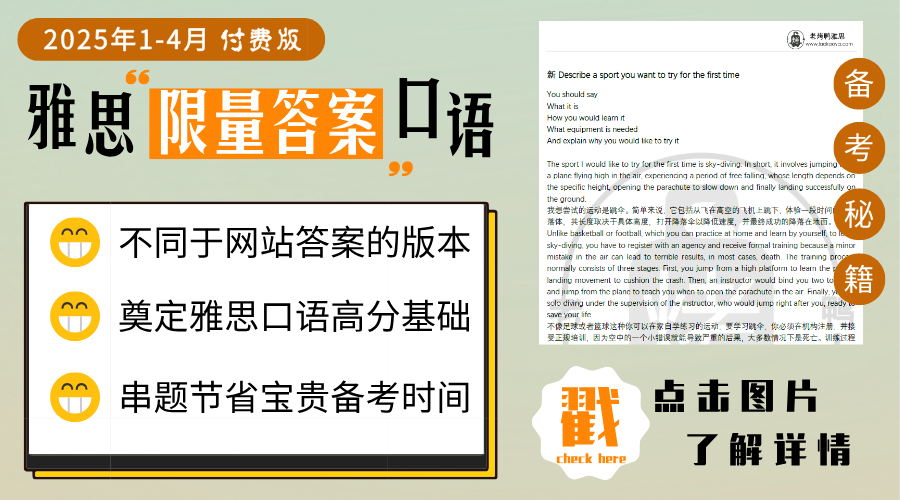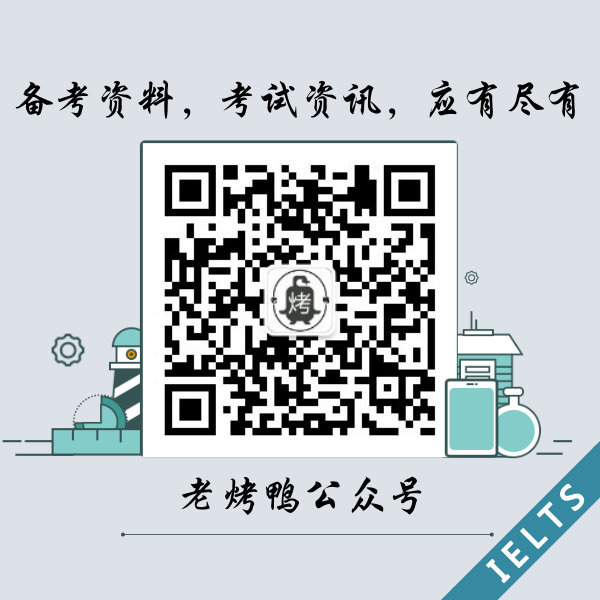剑桥雅思12Test8Passage1阅读原文翻译 The History of Glass 玻璃的历史
剑桥雅思12阅读第八套题目第一篇文章的主题为玻璃的历史。文章一共7段,按照时间顺序介绍了玻璃从无到有,再到无处不在的发展过程。下面是具体每一段的翻译,以供大家参考。
点击查看这篇雅思阅读中需要大家掌握的重点词汇以及对应的答案解析:
雅思真题阅读词汇 剑桥雅思12 test 8 passage 1 玻璃的历史
剑桥雅思12Test8Passage1阅读答案解析 The History of Glass 玻璃的历史
剑桥雅思12 Test8 Passage1阅读原文翻译
第1段
From our earliest origins, man has been making use of glass. Historians have discovered that a type of natural glass — obsidian — formed in places such as the mouth of a volcano as a result of the intense heat of an eruption melting sand — was first used as tips for spears. Archaeologists have even found evidence of man-made glass which dates back to 4000 BC; this took the form of glazes used for coating stone beads. It was not until 1500 BC, however, that the first hollow glass container was made by covering a sand core with a layer of molten glass.
从我们最早的起源开始,人类就一直在使用玻璃。历史学家发现,一种通常形成于火山口一类的地方(由于火山爆发的高温融化了沙子)的天然玻璃-黑曜石-被当作矛尖使用。考古学家甚至发现过可以追溯到公元前4000年的人造玻璃的证据,即用来包裹石头珠子的玻璃涂层。然而,直到公元前1500年,通过用融化的玻璃覆盖沙子模型才制作出第一个中空的玻璃容器。
第2段
Glass blowing became the most common way to make glass containers from the first century BC. The glass made during this time was highly coloured due to the impurities of the raw material. In the first century AD, methods of creating colourless glass were developed, which was then tinted by the addition of colouring materials. The secret of glass making was taken across Europe by the Romans during this century. However, they guarded the skills and technology required to make glass very closely, and it was not until their empire collapsed in 476 AD that glass-making knowledge became widespread throughout Europe and the Middle East. From the 10th century onwards, the Venetians gained a reputation for technical skill and artistic ability in the making of glass bottles, and many of the city’s craftsmen left Italy to set up glassworks throughout Europe.
从公元前1世纪开始,吹玻璃就是制作玻璃容器最常见的方法。由于原材料中存在杂质,这一时期制作的玻璃颜色各异。公元1世纪,制造无色玻璃的方法被发明出来。这些玻璃可以通过添加有色材料来沾染其他颜色。同样在该世纪,罗马人将玻璃制造的秘密带到欧洲。但他们十分严密的保守制作玻璃的工艺和技术。直到罗马帝国于公元476年崩溃,玻璃制作的知识文章来自老烤鸭雅思才在欧洲和中东广泛传播。从10世纪开始,威尼斯人因制作玻璃瓶子的高超技术和艺术水准而声名远扬。这座城市的许多手工艺人离开意大利,在欧洲各地建立自己的玻璃作坊。
第3段
A major milestone in the history of glass occurred with the invention of lead crystal glass by the English glass manufacturer George Ravenscroft (1632—1688). He attempted to counter the effect of clouding that sometimes occurred in blown glass by introducing lead to the raw materials used in the process. The new glass he created was softer and easier to decorate, and had a higher refractive index, adding to its brilliance and beauty, and it proved invaluable to the optical industry. It is thanks to Ravenscroft’s invention that optical lenses, astronomical telescopes, microscopes and the like became possible.
玻璃发展史上的一个重要里程碑是英国玻璃制造商George Ravenscroft (1632-1588)发明了铅水晶玻璃。为了消除在吹制玻璃中有时发生的雾化效应,他在该过程所使用的原材料中加入了铅。他制造的新玻璃更柔软,更容易装饰,并且有着更高的折射率,增加了玻璃本身的亮度和美感。这对于光学工业来说价值无限。正是由于Ravenscroft的发明,光学镜片、天文望远镜、显微镜和诸如此类的东西才成为可能。
第4段
In Britain, the modern glass industry only really started to develop after the repeal of the Excise Act in 1845. Before that time, heavy taxes had been placed on the amount of glass melted in a glasshouse, and were levied continuously from 1745 to 1845. Joseph Paxton’s Crystal Palace at London’s Great Exhibition of 1851 marked the beginning of glass as a material used in the building industry. This revolutionary new building encouraged the use of glass in public, domestic and horticultural architecture. Glass manufacturing techniques also improved with the advancement of science and the development of better technology.
在英国,现代玻璃产业直到1845年废除消费税法之后才开始真正起步。在这之前,玻璃作坊中所融化的玻璃被征以重税,而且这一税收在1745年到1845年之间被持续收取。Joseph Paxton为1851年伦敦世界博览会所设计的水晶宫殿标志着玻璃开始作为一种材料被应用于建筑工业中。这一革命性的新建筑鼓励在人们在公共、私人以及园艺建筑中使用玻璃。随着科学的进步和更好技术的出现,玻璃制作工业也有所提升。
第5段
From 1887 onwards, glass making developed from traditional mouth-blowing to a semi-automatic process, after factory-owner HM Ashley introduced a machine capable of producing 200 bottles per hour in Castleford, Yorkshire, England — more than three times quicker than any previous production method. Then in 1907, the first fully automated machine was developed in the USA by Michael Owens — founder of the Owens Bottle Machine Company (later the major manufacturers Owens- Illinois) — and installed in its factory. Owens’ invention could produce an impressive 2,500 bottles per hour. Other developments followed rapidly, but it was not until the First World War, when Britain became cut off from essential glass suppliers, that glass became part of the scientific sector. Previous to this, glass had been seen as a craft rather than a precise science.
从1887年开始,玻璃制作从传统的人工吹制进化到半自动流程。当时的工厂主HM Ashley在英格兰约克郡的Castleford引进了一台每小时可以生产出200个瓶子的机器。这比之前任何生产方法都快了不止3倍。随后,1907年,美国的Michael Owens(Owens Bottle Machine Company的创始人,即后来的大型制造商Owens-Illinois)开发出第一台全自动机器,并将它安装在自己的工厂里。Owens的发明可以每小时制造出令人惊叹的2500个瓶子。其他的进展很快跟上。但直到第一次世界大战,英国失去其主要的玻璃供应商,玻璃才成为科学研究的一部分。在此之前,玻璃被当作是手工艺品,而非精确的科学。
第6段
Today, glass making is big business. It has become a modern, hi-tech industry operating in a fiercely competitive global market where quality, design and service levels are critical to maintaining market share. Modern glass plants are capable of making millions of glass containers a day in many different colours, with green, brown and clear remaining the most popular. Few of us can imagine modern life without glass. It features in almost every aspect of our lives — in our homes, our cars and whenever we sit down to eat or drink. Glass packaging is used for many products, many beverages are sold in glass, as are numerous foodstuffs, as well as medicines and cosmetics.
如今,玻璃制造是一门大生意。它已经成为竞争激烈的全球市场上一项现代高科技产业。质量,设计和服务水平对于维持市场份额至关重要。现代玻璃工厂能够在一天里制造数百万各种不同颜色的玻璃。其中绿色、棕色和透明色仍然最为流行。我们很难想象没有玻璃的现代生活。它几乎出现在我们生活的方方面面-在我们的家里,汽车里,以及任何我们想要坐下吃饭或者喝水的时候。玻璃包装被用于许多产品,很多饮料都以玻璃瓶的形式出售,同样的还有无数的食物,药品和化妆品。
第7段
Glass is an ideal material for recycling, and with growing consumer concern for green issues, glass bottles and jars are becoming ever more popular. Glass recycling is good news for the environment. It saves used glass containers being sent to landfill. As less energy is needed to melt recycled glass than to melt down raw materials, this also saves fuel and production costs. Recycling also reduces the need for raw materials to be quarried, thus saving precious resources.
玻璃是回收利用的理想材料。随着越来越多的消费者关心环境问题,玻璃瓶罐的受欢迎程度与日俱增。玻璃回收对于环境来说是条好消息。它能够留下本来要送往垃圾填埋场的玻璃容器。由于融化回收玻璃所需要的能量比融化原材料要少,这一举措也可以节省燃料和生产成本。回收也会降低开采原材料的需求,并因此节约宝贵的资源。
剑桥雅思12Test8Passage2阅读原文翻译 bring back the big cats
剑桥雅思12Test8Passage3阅读原文翻译 UK companies need more effective boards of directors


